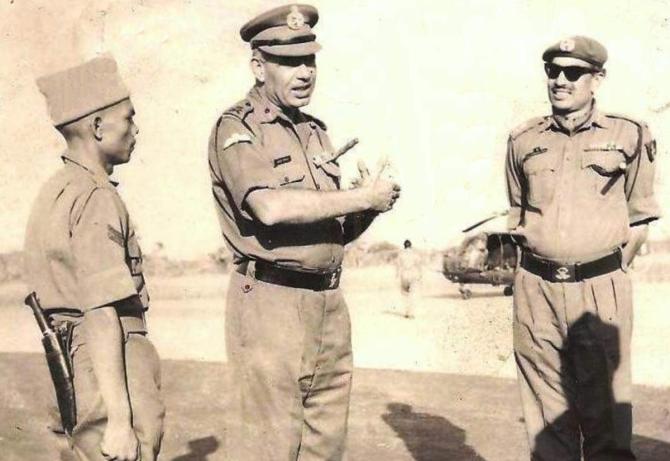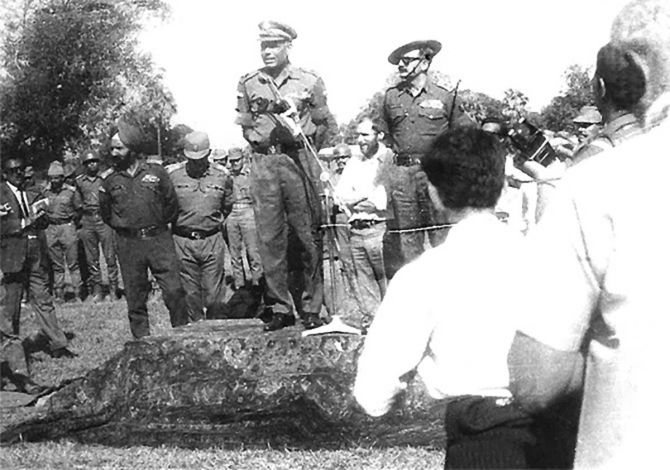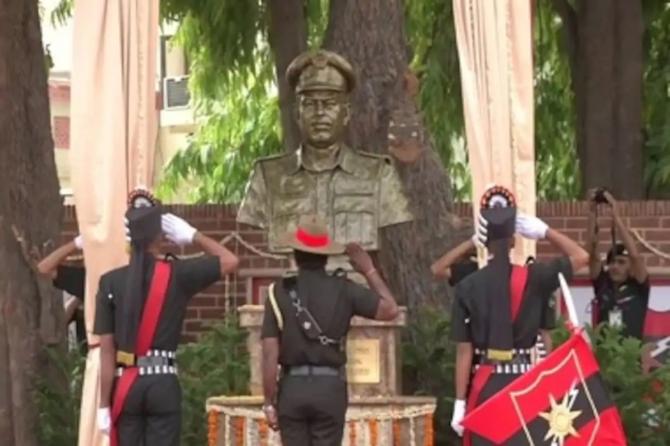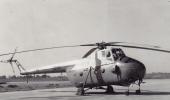'A great General who had become a legend in his lifetime.'
'India will not see the likes of Sagat Singh again.'
Prakash Bhandari salutes the memory of the military genius who captured Dacca in the 1971 War.

2021 is the golden jubilee year of the formation of Bangladesh. In the cold month of December 1971, brave Indian soldiers captured 93,000 Pakistani prisoners in 14 days of a multi-front military engagement that saw the birth of a new nation.
Lieutenant General Sagat Singh was the unsung hero of that war, instrumental in the fall of Dacca.
General Sagat was the General Officer Commanding of the Tezpur (Assam)-based 4 Corps and it was he who, despite being injured by machine-gun fire, successfully conducted the daring night-time heliborne operations over the rivers of then East Pakistan and the treacherous terrain which ensured the fall of Dacca so quickly and decisively, leading to the historic surrender at the Dacca Racecourse at 4.32 pm on December 16, 1971.

Sagat Singh joined the army as a sepoy in the erstwhile princely state of Bikaner and rose to become a general. He was a born military hero and it seemed that his whole life was geared to leading his men into battle.
"In 1971, in a major logistic achievement, he moved his Corps to Agartala. When the operations commenced, his Corps relentlessly attacked and defeated the Pakistani forces, crossed river lines and terrain considered impossible in an innovative use of helicopters that has never been repeated," recalls Major General Randhir Singh (retd), ADC to General Sagat during the 1971 War.
"His knowledge of operational war was perhaps without parallel," adds General Randhir, author of a book on General Sagat. "He can be compared with the best generals of the First and Second World Wars."

After the Instrument of Surrender was signed on December 16, 1971, then prime minister Indira Gandhi visited Dacca, profusely thanked General Sagat and saw to it that he stayed in Dacca to assist the Mujibur Rahman government.
Colonel Ranvijay Singh (retd), General Sagat's son, remembers that his father always led from the front and no matter how difficult a mission was, carried the under-command with him.
Even as a very senior commander, adds the colonel, he exposed himself routinely to danger -- he narrowly escaped death many times -- and went beyond the call of duty to achieve the "task plus" by capturing Dacca in a very unique way.
Colonel Ranvijay says his father differed in tactics and strategy with the higher command, and that is how courageously he lived his life.
In his foreword to General Randhir's book A Talent For War: The Military Biography of Lt Gen Sagat Singh, Lieutenant General S K Sinha (retd), who later became the governor of Jammu and Kashmir, writes: 'This biography... describes in detail how the most distinguished battlefield commander of the Indian Army conducted operations during the liberation of Goa, handled insurgency in Mizoram, broke the myth of ten feet tall Chinese soldiers by getting the better of them during a big skirmish in Sikkim and provided dynamic leadership to his Corps against all odds, leading his formation from the front in the Indo-Pak War of 1971.'
'His outstanding leadership was a major factor contributing to the unprecedented victory of the Indian Army in over a millennium,' declares General Sinha.

After the war, when General Sagat was superseded and his junior, Lieutenant General K K Singh, was made his boss, General Sinha said, 'I considered it very unfortunate that the higher-ups should treat a war hero who had done so much for the country in such an unfair and unjust manner.'
On General Sagat's death, General K K Singh paid him the ultimate tribute: 'A great General who had become a legend in his lifetime. India will not see the likes of Sagat Singh again.'

Towards the end of 1991, I called on General Sagat and his wife Kamla Kumari at Meghna, their appropriately named bungalow after the river in Bangladesh. The general, a strikingly handsome and supremely confident man, was in the autumn of his life. At 6' 3" -- towering over us all -- the war hero stood ramrod straight, and with no bitterness.
Among the many things he told me that day in Jaipur, one distinctly stands out in my mind: "em>Bhay kya hota hai, maine aaj tak nahi jana (I know not what fear is)."
"I have not known anyone -- before or since -- who could say it with such conviction," asserts General Randhir Singh.
General Sagat Singh passed away in 2001. One of India's and the world's finest generals, he deserves to be remembered and honoured much more than he has been.
Prakash Bhandari is a veteran political commentator based in Jaipur.
Feature Presentation: Rajesh Alva/Rediff.com










